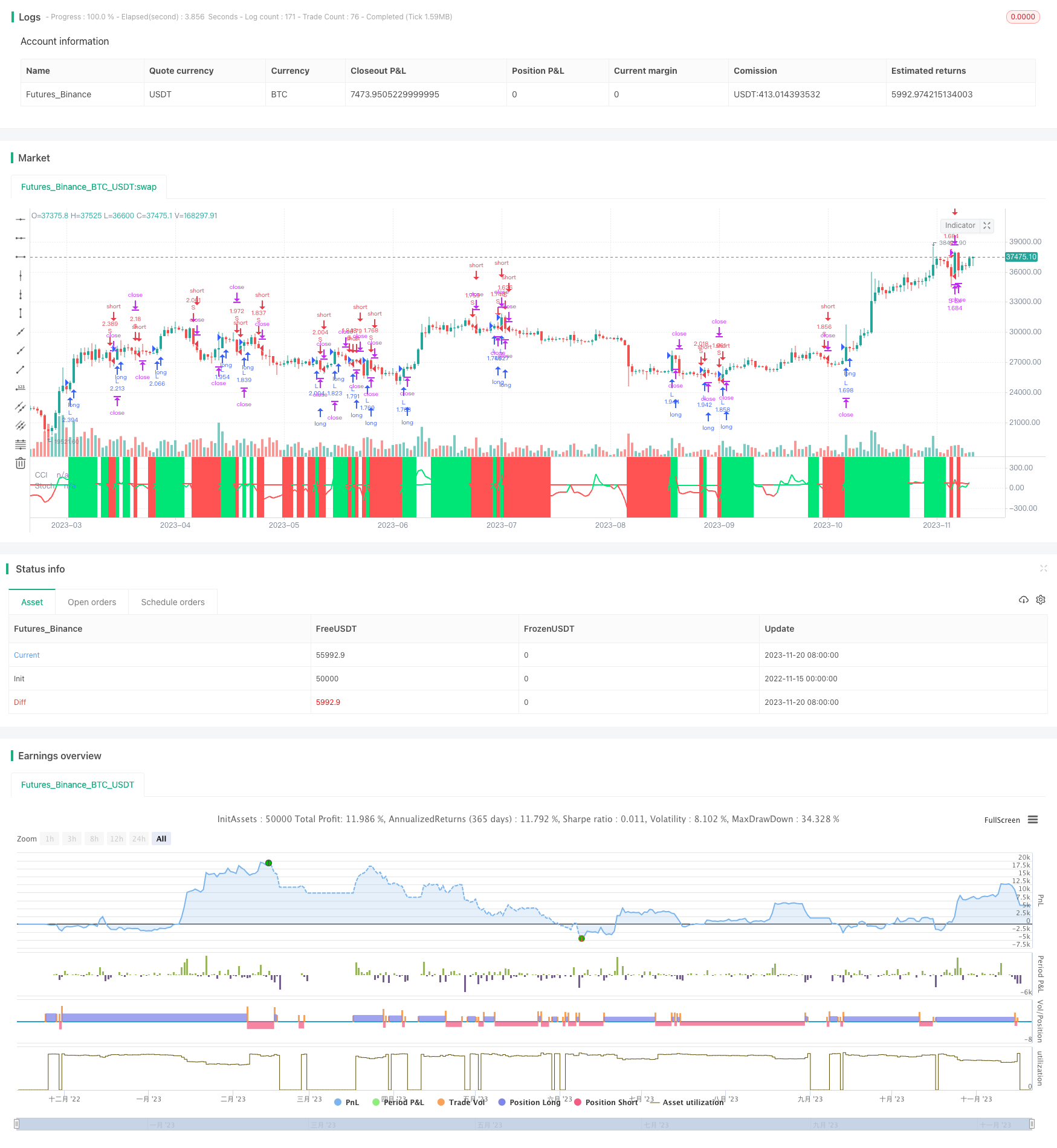
概述
该策略结合了Stochastic指标和CCI指标,以识别趋势方向,利用Rate of Change指标过滤掉震荡趋势,实现对趋势的跟踪。策略采用突破入场,止损出场的交易方式。
策略原理
- Stochastic指标判断多空形态
当Stochastic指标上穿其最近一个bar时为买入信号,下穿其最近一个bar时为卖出信号 - CCI指标判断趋势方向
CCI大于0为多头市场,小于0为空头市场 - Rate of Change指标过滤震荡趋势
设置Rate of Change的参数,判断价格是否处于活跃的趋势中 - 入场和出场规则
买入信号:Stochastic上穿最近一个bar且CCI大于0且价格趋势活跃
卖出信号:Stochastic下穿最近一个bar且CCI小于0且价格趋势活跃
止损 exit: 长线 3% 止损,短线 3% 止损
优势分析
- 结合Stochastic指标和CCI指标判断趋势方向,精确率较高
- Rate of Change指标可有效滤掉震荡趋势,避免无效交易
- 多空双向交易,可捕捉不同类型的趋势
- 突破入场追趋势,及时把握趋势机会
- 严格止损规避重大损失,有效控制风险
风险分析
- 策略参数设置不当可能导致过于保守或激进
- 指标作用有限,极端行情下可能失效
- 突破入场会略过趋势初期,部分利润被切割
- 止损过小容易被突破,过大则风险控制不当
优化方向
- 参数优化。改进参数设置,寻找最优参数组合
- 多标配合。加入更多判断趋势的指标,提高决策效果
- 积极止损。设置追踪止损或时间步移止损,减少止损被突破概率
- 风险评估。加入最大回撤等风险指标约束,全面控制风险敞口
总结
该策略整合 Stochastic、CCI 和 Rate of Change 三大指标判断趋势方向,以突破追踪的方式把握趋势机会。策略优势在于指标搭配判断准确,有效过滤震荡行情,通过严格的止损控制风险。下一步可从参数优化、多标配合、止损策略等方面进行改进,使策略更稳健、灵活。
策略源码
/*backtest
start: 2022-11-15 00:00:00
end: 2023-11-21 00:00:00
period: 1d
basePeriod: 1h
exchanges: [{"eid":"Futures_Binance","currency":"BTC_USDT"}]
*/
//@version=4
strategy("Stochastic CCI BF 🚀", overlay=false, initial_capital=10000, default_qty_type=strategy.percent_of_equity, default_qty_value=100, commission_type=strategy.commission.percent, commission_value=0.075)
/////////////// Time Frame ///////////////
testStartYear = input(2017, "Backtest Start Year")
testStartMonth = input(1, "Backtest Start Month")
testStartDay = input(1, "Backtest Start Day")
testPeriodStart = timestamp(testStartYear,testStartMonth,testStartDay, 0, 0)
testStopYear = input(2019, "Backtest Stop Year")
testStopMonth = input(12, "Backtest Stop Month")
testStopDay = input(31, "Backtest Stop Day")
testPeriodStop = timestamp(testStopYear,testStopMonth,testStopDay, 0, 0)
testPeriod() => true
///////////// CCI /////////////
src = close
ccilength = input(13, minval=1, title="CCI Length")
c=cci(src, ccilength)
///////////// Stochastic /////////////
len = input(19, minval=1, title="RSI Length")
lenema = input(12, minval=1, title="RSI-EMA Length")
up = rma(max(change(src), 0), len)
down = rma(-min(change(src), 0), len)
rsi = down == 0 ? 100 : up == 0 ? 0 : 100 - (100 / (1 + up / down))
out = ema(rsi, lenema)
///////////// Rate Of Change /////////////
source = close
roclength = input(30, minval=1)
pcntChange = input(7.0, minval=1)
roc = 100 * (source - source[roclength]) / source[roclength]
emaroc = ema(roc, roclength / 2)
isMoving() => emaroc > (pcntChange / 2) or emaroc < (0 - (pcntChange / 2))
/////////////// Strategy ///////////////
long = out > out[1] and isMoving() and c > 0
short = out < out[1] and isMoving() and c < 0
last_long = 0.0
last_short = 0.0
last_long := long ? time : nz(last_long[1])
last_short := short ? time : nz(last_short[1])
long_signal = crossover(last_long, last_short)
short_signal = crossover(last_short, last_long)
last_open_long_signal = 0.0
last_open_short_signal = 0.0
last_open_long_signal := long_signal ? open : nz(last_open_long_signal[1])
last_open_short_signal := short_signal ? open : nz(last_open_short_signal[1])
last_long_signal = 0.0
last_short_signal = 0.0
last_long_signal := long_signal ? time : nz(last_long_signal[1])
last_short_signal := short_signal ? time : nz(last_short_signal[1])
in_long_signal = last_long_signal > last_short_signal
in_short_signal = last_short_signal > last_long_signal
last_high = 0.0
last_low = 0.0
last_high := not in_long_signal ? na : in_long_signal and (na(last_high[1]) or high > nz(last_high[1])) ? high : nz(last_high[1])
last_low := not in_short_signal ? na : in_short_signal and (na(last_low[1]) or low < nz(last_low[1])) ? low : nz(last_low[1])
sl_inp = input(3.0, title='Stop Loss %') / 100
since_longEntry = barssince(last_open_long_signal != last_open_long_signal[1])
since_shortEntry = barssince(last_open_short_signal != last_open_short_signal[1])
slLong = in_long_signal ? strategy.position_avg_price * (1 - sl_inp) : na
slShort = strategy.position_avg_price * (1 + sl_inp)
long_sl = in_long_signal ? slLong : na
short_sl = in_short_signal ? slShort : na
/////////////// Execution ///////////////
if testPeriod()
strategy.entry("L", strategy.long, when=long_signal)
strategy.entry("S", strategy.short, when=short_signal)
strategy.exit("L Ex", "L", stop=long_sl, when=since_longEntry > 0)
strategy.exit("S Ex", "S", stop=short_sl, when=since_shortEntry > 0)
/////////////// Plotting ///////////////
bgcolor(long_signal ? color.lime : short_signal ? color.red : na, transp=30)
bgcolor(not isMoving() ? color.white : long ? color.lime : short ? color.red : na, transp=80)
plot(out, color = out > out[1] ? color.lime:color.red, linewidth = 2, title="Stoch")
plot(c, color = c > 0 ? color.lime:color.red, linewidth = 2, title="CCI")